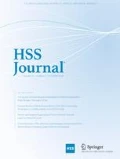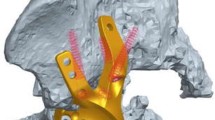Abstract
Pelvic discontinuity is a complex entity with a high surgical complication rate and no standardized treatment to date. Revision hip arthroplasty in cases of massive bone loss remains a difficult and unsolved problem. The goal of the surgeon is to preserve limb function by restoring bone stock and the biomechanics of the hip. In cases of severe acetabular bone loss, biologic fixation is often inadequate, requiring extensive bone grafting and reconstructive cages. Reconstructive cages are the most commonly used devices and are designed to bridge bone defects, protect the bone graft, and reestablish the rotation center of the hip. A major limitation of current cages is that they do not allow for biologic fixation. We review the options for treating patients with massive bone loss and pelvic discontinuity and discuss therapeutic options and the clinical and radiological criteria for success.






Similar content being viewed by others
Abbreviations
- BS:
-
Burch–Schneider cage
- CC:
-
contour cup cage
- NSPD:
-
not specified for pelvic discontinuity
References
O’Rourke MR, Paprosky WG, Rosemberg AG (2004) Use of structural allografts in acetabular revision surgery. Clin Orthop 420:113–121
Berry DJ, Lewallen DG, Hanssen AD et al (1999) Pelvic discontinuity in revision total hip arthroplasty. J Bone Joint Surg Am 81:1692–1702
Harris WH (1998) Reconstruction at a high hip center in acetabular revision surgery using a cementless acetabular component. Orthopedics 21:991–992
Tanzer M (1998) Role and results of the high hip center. Orthop Clin North Am 29:241–247
Jasty M (1998) Jumbo cups and morselized graft. Orthop Clin North Am 29:249–254
De Boer DK, Christie MJ (1998) Reconstruction of the deficient acetabulum with an oblong prosthesis: three to seven year results. J Arthroplasty 13:674–680
Koster G, Willert HG, Kohler HP et al (1998) An oblong revision cup for large acetabular defects: design rationale and two to seven year follow up. J Arthroplasty 13:559–569
Gill TJ, Sledge JB, Mueller ME (1998) The Burch–Schneider anti-protrusio cage in revision hip arthroplasty. Indications, principles and long-term results. J Bone Joint Surg Br 80:946–953
Garbuz D, Mosri E, Mohammed N et al (1996) Classification and reconstruction in revision acetabular arthroplasty with bone stock deficiency. Clin Orthop 324:98–107
Goodman S, Sastamoinen H, Shasha N et al (2004) Complications of ilio-ischial reconstructions rings in revision total hip arthroplasty. J Arthroplasty 19:436–446
Holt GE, Dennis DA (2004) Use of custom triflanged acetabular components in revision total hip arthroplasty. Clin Orthop 429:209–214
Nehme A, Lewallen DG, Hanssen AD (2004) Modular porous metal augments for treatment of severe acetabular bone loss during revision hip arthroplasty. Clin Orthop 429:201–208
Peters CL, Miller M, Erickson J et al (2004) Acetabular revision with a modular anti-protrusio acetabular component. J Arthroplasty 19:67–72
Chiang PP, Burke DW, Freiberg AA et al (2003) Osteolysis of the pelvis. Evaluation and treatment. Clin Orthop 417:164–174
D’Antonio JA, Capello WN, Borden LS et al (1989) Classification and management of acetabular abnormalities in total hip arthroplasty. Clin Orthop 243:126–137
Saleh KJ, Holtzman J, Gafni A et al (2001) Development, test reliability and validation of a classification for revision hip arthroplasty. J Orthop Res 19:50–56
Saleh KJ, Jaroszynski G, Woodgate I et al (2000) Revision total hip arthroplasty with the use of structural acetabular allograft and reconstruction ring. A case series with a 10 year average follow-up. J Arthroplasty 15:951–958
Paprosky WG, Perona PG, Lawrence JM (1994) Acetabular defect classification and surgical reconstruction in revision arthroplasty: a 6-year follow up evaluation. J Arthroplasty 9:33–44
Gross AE (1999) Revision arthroplasty of the acetabulum with restoration of bone stock. Clin Orthop S369:198–207
Stiehl JB, Saluja R, Diener T (2000) Reconstruction of major column defects and pelvic discontinuity in revision total hip arthroplasty. J Arthroplasty 15:849–857
Udomkiat P, Dorr LD, Won YY et al (2001) Technical factors for success with metal ring acetabular reconstruction. J Arthroplasty 16:961–969
Wachtl S, Jung M, Jakob R et al (2000) The Burch–Schneider antiprotrusio cage in acetabular revision surgery. A mean follow-up of 12 years. J Arthroplasty 15:959–963
Gross AE, Goodman S (2004) The current role of structural grafts and cages in revision arthroplasty of the hip. Clin Orthop 429:193–200
Eggli S, Muller C, Ganz R (2002) Revision surgery in pelvic discontinuity. An analysis of seven patients. Clin Orthop 398:136–145
Murphy SB (2005) Management of acetabular bone stock deficiency. J Arthroplasty 20(S2):85–90
Mahoney CR, Garvin KL (2002) Periprosthetic acetabular stress fracture causing pelvis discontinuity. Orthopedics 25:83–85
Springer BD, Berry DJ, Cabanela ME et al (2005) Early postoperative transverse pelvis fracture: a new complication related to revision arthroplasty with an uncemented cup. J Bone Joint Surg Am 87:2626–2632
Scott MS, O’Rourke M, Chong P et al (2005) The use of structural distal femoral allografts for acetabular reconstruction. J Bone Joint Surg Am 87:760–765
Shinar AA, Harris WH (1997) Bulk structural autogenous grafts and allografts for reconstruction of the acetabulum in total hip arthroplasty. Sixteen year average follow up. J Bone Joint Surg Am 79:159–168
Sporer S, O’Rourke M, Paprosky W (2005) The treatment of pelvic discontinuity during acetabular revision. J Arthroplasty 20:79–84
Kerboull M, Hamadouche M, Kerboull L (2000) The Kerboull acetabular reinforcement device in major acetabular reconstructions. Clin Orthop 378:155–168
Lietman SA, Bhawnani K (2001) The partial pelvic replacement cup in severe acetabular defects. Orthopedics 24:1131–1135
Ko PS, Chan WF, Wong MK et al (2004) Fixation using acetabular reconstruction cage and cancellous allografts for intraoperative acetabular fractures associated with cementless acetabular component insertion. J Arthroplasty 19:643–646
Berry DJ (2004) Antiprotrusio cages for acetabular revision. Clin Orthop 420:106–112
Shatzker J, Wong M (1999) Acetabular revision. The role of rings and cages. Clin Orthop 369:187–197
Böstrom MP, Lehman AP, Buly RL, Lyman S et al (2006) Acetabular revision with the contour antiprotrusio cage, 2- to 5-year followup. Clin Orthop 453:188–194
Paprosky W, Sporer S, O’Rourke M (2006) The treatment of pelvic discontinuity with acetabular cages. Clin Orthop 453:183–187
Christie MJ, Barrington SA, Brinson MF et al (2001) Bridging massive acetabular defects with the triflanged cup: 2 to 9 years result. Clin Orthop 393:216–227
Joshi AB, Lee J, Christensen C (2002) Results for a custom acetabular component for acetabular deficiency. J Arthroplasty 17:643–648
Levine B, Della Valle C, Jacobs J (2006) Applications of porous tantalum in total hip arthroplasty. J Am Acad Orthop Surg 14:646–665
Sporer SM, Paprosky WG (2006) Acetabular revision using a trabecular metal acetabular component for severe acetabular bone loss associated with a pelvic discontinuity. J Arthroplasty 21:87–90
Hanssen AD, Lewallen DG (2004) Acetabular cages. A ladder across a melting pond. Orthopedics 27:830–32
Gross AE, Goodman SB (2005) Rebuilding the skeleton. The intraoperative use of trabecular metal in revision total hip arthroplasty. J Arthroplasty 20:91–93
Nercessian OA (1999) Intraoperative complications. In: Steinberg ME, Garino JP (eds) Revision hip arthroplasty. Lippincott, Williams and Wilkins, Philadelphia, pp 443–456
Dennis DA (2003) Management of massive acetabular defects in revision total hip arthroplasty. J Arthroplasty 18:121–125
Winter E, Piert M, Volkmann R et al (2001) Allogeneic cancellous bone graft and a Bursch–Schneider ring for acetabular reconstruction in revision hip arthroplasty. J Bone Joint Surg 83A:862–867
Cook SD, Barrack RL, Shimmin A et al (2001) The use of osteogenic protein-1 in reconstructive surgery of the hip. J Arthroplasty 16:88–94
Gamradt SC, Lieberman JR (2003) Bone graft for revision hip arthroplasty. Biology and future applications. Clin Orthop 417:183–194
Speirs AD, Oxland TR, Masri BA et al (2005) Calcium phosphate cement composite in revision hip arthroplasty. Biomaterials 26:7310–7318
Kärrholm J, Hourigan P, Timperley J et al (2006) Mixing bone graft with OP-1 does not improve cup or stem fixation in revision surgery of the hip. 5-year follow-up of 10 acetabular and 11 femoral study cases and 40 control cases. Acta Orthop Scan 77:39–48
McDonald SJ, Mehin R. (2005) Acetabular revision: structural grafts. Advanced reconstruction. Hip. In Lieberman JR and Berry DJ (Ed) AAOS, pp 335–342
Slooff TJ, Gardeniers JW, Schreurs BW et al (1999) Acetabular bone grafting: impacted cancellous allografts. In: Steinberg ME, Garino JP (eds) Revision hip arthroplasty. Lippincott, Williams and Wilkins, Philadelphia, pp 249–261
Schreurs BW, Slooff TJ, Gardeniers JW et al (2001) Acetabular reconstruction with bone impaction grafting and a cemented cup. Clin Orthop 393:202–215
Van Haaren EH, Heyligers IC, Alexander FG, Wuisman PI (2007) High rate of failure of impaction grafting in large acetabular defects. J Bone Joint Surg Br 89(3):296–300
Acknowledgements
The authors sincerely thank Mr. Thomas O’Boyle and the Foundation for Biomedical Investigation of “Hospital General Universitario Gregorio Marañón” for editorial assistance.
Author information
Authors and Affiliations
Corresponding author
Additional information
Level of evidence. Level V. Expert Opinion.
Rights and permissions
About this article
Cite this article
Villanueva, M., Rios-Luna, A., Pereiro De Lamo, J. et al. A Review of the Treatment of Pelvic Discontinuity. HSS Jrnl 4, 128–137 (2008). https://doi.org/10.1007/s11420-008-9075-6
Received:
Accepted:
Published:
Issue Date:
DOI: https://doi.org/10.1007/s11420-008-9075-6




